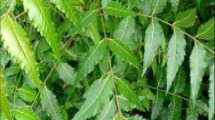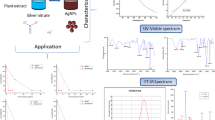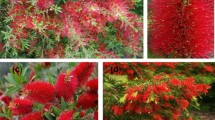Abstract
Vector control is a critical requirement in epidemic disease situations, as is an urgent need to develop new and improved mosquito control methods that are economical and effective yet safe for nontarget organisms and the environment. Mosquitoes transmit serious human diseases, causing millions of deaths every year. Use of synthetic insecticides to control vector mosquitoes has caused physiological resistance and adverse environmental effects in addition to high operational cost. Insecticides of synthesized natural products for vector control have been a priority in this area. In the present study, activity of silver nanoparticles (AgNPs) synthesized using Euphorbia hirta (E. hirta) plant leaf extract against malarial vector Anopheles stephensi (A. stephensi) was determined. Range of concentrations of synthesized AgNPs (3.125, 6.25, 12.5, 25, and 50 ppm) and methanol crude extract (50, 100, 150, 200, and 250 ppm) were tested against larvae of A. stephensi. The synthesized AgNPs from E. hirta were highly toxic than methanolic crude extract against malarial vector, A. stephensi. The synthesized AgNPs were characterized by UV-vis spectrum, scanning electron microscopy (SEM), and X-ray diffraction. SEM analyses of the synthesized showed that AgNPs, measuring 30–60 nm in size, were clearly distinguishable. The synthesized AgNPs showed larvicidal effects after 24 h of exposure; however, the highest larval mortality was found in the synthesized AgNPs against the first to fourth instar larvae and pupae of values LC50 (10.14, 16.82, 21.51, and 27.89 ppm, respectively), LC90 (31.98, 50.38, 60.09, and 69.94 ppm, respectively), and the LC50 and LC90 values of pupae of 34.52 and 79.76 ppm, respectively. Methanol extract exhibited the larval toxicity against the first to fourth instar larvae and pupae of values LC50 (121.51, 145.40, 169.11, and 197.40 ppm, respectively), LC90 (236.44, 293.75, 331.42, and 371.34 ppm, respectively), and the LC50 and LC90 values of pupae of 219.15 and 396.70 ppm, respectively. No mortality was observed in the control. These results suggest that synthesized silver nanoparticles are a rapid, eco-friendly, and single-step approach; the AgNPs formed can be potential mosquito larvicidal agents.





Similar content being viewed by others
References
Abbott WS (1925) A method of computing the effectiveness of insecticides. J Eco Ento 18:265–267
Abdul Rahuman A, Gopalakrishnan G, Venkatesan P, Geetha K (2007) Larvicidal activity of some Euphorbiaceae plant extracts against Aedes aegypti and Culex quinquefasciatus (Diptera: Culicidae), Parasitology Research 839–6
Ahmad A, Mukherjee P, Senapati S, Mandal D, Khan MI, Kumar R, Sastry M (2003) Extracellular biosynthesis of silver nanoparticles using the fungus Fusarium oxysporum. Colloids Surf B 28:313–318
Alder HL, Rossler EB (1977) Introduction to probability and statistics, 6th edn. W.H. Freeman Company, San Francisco, p 246
AlesPana C, Milan KR, Renata V, Robert P, Jana S, Vladimır K, Petr H, Radek Z, Libor K (2009) Antifungal activity of silver nanoparticles against Candida spp. Biomaterials 30:6333–6340
Ankamwar B, Damle C, Absar A, Mural S (2005) Biosynthesis of gold and silver nanoparticles using Emblica officinalis fruit extract, their phase transfer and transmetallation in an organic solution. J Nanosci Nanotechnol 10:1665–1671
Balaji DS, Basavaraja S, Deshpande R, Mahesh DB, Prabhakar BK, Venkatraman A (2009) Extracellular biosynthesis of functionalized silver nanoparticles by strains of Cladosporium cladosporioides fungus. Colloides Surf B Biointerf 68(1):88–92
Brands SJ (comp.) (1989) The taxonomicon. Universal Taxonomic Services, Zwaag, the Netherlands. Accessed February 5, 2012 (Zipcodezoo)
Casida JE, Quistad GB (2005) Insecticide targets: learning to keep up with resistance and changing concepts of safety. Agric Chem Biotechnol 43:185–191
Chandran SP, Chaudhary M, Pasricha R, Ahmad A, Sastry M (2006) Synthesis of gold nanotriangles and silver nanoparticles using Aloe vera plant extract. Biotechnol Prog 22:577–583
Chen L (1991) Studies on the polyphenols from leaves of Euphorbia hirta L. [J]. China J Chin Mater Med 16(1):38–39
Elumalai EK, Prasad TNVKV, Hemachandran J, Therasa SV, Thirumalai T, David E (2010) Extracellular synthesis of silver nanoparticles using leaves of Euphorbia hirta and their antibacterial activities. J Pharm Sci Res 2(9):549–554
Fayaz AM, Balaji K, Girilal M, Yadav R, Thangavelu P, Venketesan KR (2010) Biogenic synthesis of silver nanoparticles and their synergistic effect with antibiotics: a study against gram-positive and gram-negative bacteria. Nanomed Nanotechnol Biol Med 6:103–109
Finney DJ (1971) Probit analysis. Cambridge University Press, London, pp 68–78
Gong P, Li H, He X, Wang K, Hu J, Tan W, Zhang S, Yang X (2007) Preparation and antibacterial activity of Fe3O4@Ag nanoparticles. Nanotechnol 18:285604
Goodsell DS (2004) Bionanotechnology: lessons from nature. Wiley-Liss, Hoboken
Govindarajan M, Jebanesan A, Pushpanathan T (2008) Larvicidal and ovicidal activity of Cassia fistula Linn. leaf extract against filarial and malarial vector mosquitoes. Parasitol Res 102(2):289–292
Griffitt RJ, Luo J, Gao J, Bonzongo JC, Barber DS (2008) Effects of particle composition and species on toxicity of metallic nanomaterials in aquatic organisms. Environ Toxicol Chem 27:1972–1978
Huang J, Li Q, Sun D, Lu Y, Su Y, Yang X, Wang H, Wang Y, Shao W, He N, Hong J, Chen C (2007) Biosynthesis of silver and gold nanoparticles by novel sundried Cinnamomum camphora leaf. Nanotechnology 18:105104
James VR, Christopher V, Parkinson YW, Choi JL, Speshock SM, Hussain (2008) Preliminary assessment of silver nanoparticle inhibition of monkeypox virus plaque formation. Nano Res Let 3:129–133
Jang YS, Kim MK, Ahn YS, Lee HS (2002) Larvicidal activity of Brazilian plant against Aedes aegypti and Culex pipiens (Diptera: Culicidae). Agri Chem Biotechnol 4:131–134
Jayaseelan C, Rahuman AA, Rajakumar G, Santhoshkumar T, Kirthi AV, Marimuthu S, Bagavan A, Kamaraj C, Zahir AA, Elango G, Velayutham K, Rao KV, Karthik L, Raveendran S (2011) Efficacy of plant-mediated synthesized silver nanoparticles against hematophagous parasites. Parasitol Res 11:2473–2476
Kamaraj C, Rahuman AA, Bagavan A, Elango G, Rajakumar G, Zahir AA, Marimuthu S, Santhoshkumar T, Jayaseelan C (2010) Evaluation of medicinal plant extracts against blood-sucking parasites. Parasitol Res 106:1403–1412
Kim JS, Kuk E, Yu KN, Kim JS, Park SJ, Lee HJ, Kim SH, Park YK, Park YH, Hwang CY, Kim YK, Lee YS, Jeong DH, Cho MH (2007) Antimicrobial effects of silver nanoparticles. Nanomed Nanotechnol Biol Med 3:95–101
Kovendan K, Murugan K (2011) Effect of medicinal plants on the mosquito vectors from the different agro-climatic regions of Tamil Nadu, India. Adv Environ Biol 5(2):335–344
Kovendan K, Murugan K, Prasanna Kumar K, Panneerselvam C, Mahesh Kumar P, Amerasan D, Subramaniam J, Vincent S (2012) Mosquitocidal properties of Calotropis gigantea (Family: Asclepiadaceae) leaf extract and bacterial insecticide, Bacillus thuringiensis, against the mosquito vectors. Parasitol Res. doi:10.1007/s00436-012-2865-2
Krishnaraj C, Jagan EG, Rajasekar S, Selvakumar P, Kalaichelvan PT, Mohan N (2010) Synthesis of silver nanoparticles using Acalypha indica leaf extracts and its antibacterial activity against water borne pathogens. Colloids Surf B Biointerfaces 76:50–56
Lara HH, Ayala-Nuñez NV, Ixtepan TL, Rodriguez PC (2010) Mode of antiviral action of silver nanoparticles against HIV-1. J Nanobiotech 8:1
Li S, Shen Y, Xie A, Yu X, Qiu L, Zhang L, Zhang Q (2007) Green synthesis of silver nanoparticles using Capsicum annuum L. extract. Green Chem 9:852–858
Lind EM, Tallantire AC (1971) Some common flowering plants of Uganda. Oxford University Press, Nairobi, p 182
Magana SM, Quintana P, Aguilar DH, Toledo JA, Chavez CA, Cortes MA, Leon L, Pelegrin YF, Lopez T, Sanchez RMT (2008) Antibacterial activity of montmorillonites modified with silver. J Mol Catal A 281:192–199
Mallavadhani UV, Narasimhany K (2009) Two novel butanol rhamnosides from an Indian traditional herb, Euphorbia hirta [J]. Nat Prod Res 23(7):644–651
Manusadžianas L, Grigutyt R, Jurkonien S, Karitonas R, Sadauskas K, Férard JF, Cotelle S, Foucaud L (2009) Toxicity of zinc oxide nanoparticle suspensions to aquatic biota. METZ ISTA14: VIII 30–IX 04
Marimuthu S, Rahuman AA, Rajakumar G, Santhoshkumar T, Kirthi AV, Jayaseelan C, Bagavan A, Zahir AA, Elango G, Kamaraj C (2011) Evaluation of green synthesized silver nanoparticles against parasites. Parasitol Res 10:2212–2224
Mittal PK, Adak T, Subbarao SK (2005) Inheritance of resistance to Bacillus sphaericus toxins in a laboratory selected strain of An. stephensi (Diptera: Culicidae) and its response to Bacillus thuringiensis var. israelensis. Curr Sci 89:442–443
Mohanpuria P, Rana NK, Yadav SK (2008) Biosynthesis of nanoparticles: technological concepts and future applications. J Nanopart Res 10:507–517
Mouchet F, Landois P, Sarremejean E, Bernard G, Puech P, Pinelli E, Flahaut E, Gauthier L (2008) Characterisation and in vivo ecotoxicity evaluation of double-wall carbon nanotubes in larvae of the amphibian Xenopus laevis. Aquat Toxicol 87(2):127–137
Mulvaney P (1996) Surface plasmon spectroscopy of nanosized metal particles. Langmuir 12:788–800. doi:10.1021/la9502711
Panneerselvam C, Ponarulselvam S, Murugan K (2011) Potential anti-plasmodial activity of synthesized silver nanoparticle using Andrographis paniculata Nees (Acanthaceae). Arch Appl Sci Res 3(6):208–217
Ponarulselvam S, Panneerselvam C, Murugan K, Aarthi A, Kalimuthu K, Thangamani S (2012) Synthesis of silver nanoparticles using leaves of Catharanthus roseus Linn. G. Don and their antiplasmodial activities. Asian-Pacific J Trop Biomed 574–580
Rai M, Yadav A, Gade A (2009) Silver nanoparticles as a new generation of antimicrobials. Biotechnol Adv 27:76–83
Rajkumar G, Rahuman AA (2011) Larvicidal activity of synthesized silver nanoparticles using Eclipta prostrata leaf extract against filariasis and malaria vector. Acta Trop. doi:10.1016/j.actatropica.2011.03.003
Sakulku U, Nuchuchua O, Uawongyart N, Puttipipatkhachorn S, Soottitantawat A, Ruktanonchai U (2009) Characterization and mosquito repellent activity of citronella oil nanoemulsion. Int J Pharm 8372(2):105–111
Santhoshkumar T, Rahuman AA, Rajakumar G, Marimuthu S, Bagavan A, Jayaseelan C, Zahir AA, Elango G, Kamaraj C (2011) Synthesis of silver nanoparticles using Nelumbo nucifera leaf extract and its larvicidal activity against malaria and filariasis vectors. Parasitol Res 108:693–702
Sap-Iam N, Homklinchan C, Larpudomlert R, Warisnoicharoen W, Sereemaspun A, Dubas ST (2010) UV irradiation induced silver nanoparticles as mosquito larvicides. J Applied Sci 10(23):3132–3136, ISSN 1812–5654
Saxena A, Tripathi RM, Singh RP (2010) Biological synthesis of silver nanoparticles using onion (Allium cepa) extract and their antibacterial activity. Dig J Nanomater Bios 5(2):427–432
Shankar SS, Rai A, Ankamwar B, Singh A, Ahmad A, Sastry M (2004) Nat Mater 3:482
Sharma AH, Parasher OP, Singh AT (2009) Species B of Anopheles culicifacies (Diptera: Culicidae) is reproductively less fit than species A and C of the complex. Acta Trop 112:316–319
Shin SH, Ye MK, Kim HS, Kang HS (2007) The effects of nano-silver on the proliferation and cytokine expression by peripheral blood mononuclear cells. Int Immunopharmacol 7(13):1813–1818
Shirkhanzadeh M, Azadegan M, Liu GQ (1995) Bioactive delivery systems for the slow release of antibiotics: incorporation of Ag + ions into micro-porous hydroxyapatite coatings. Mater Lett 24:7–12
Shrivastava S, Dash D (2010) Label-free colorimetric estimation of proteins using nanoparticles of silver. Nano-Micro Lett 2:164–168
Sinha S, Pan I, Chanda P, Sen SK (2009) Nanoparticles fabrication using ambient biological resources. J Appl Biosci 19:1113–1130
Soforowa EA (1982) Medicinal plants and traditional medicine in Africa. Wiley, Chichester, p 198
Song JY, Kim BS (2009) Bioproc Biosyst Eng 32:79–84
Templeton AC, Wuelfing WP, Murray RW (2000) Monolayerprotected cluster molecules. Acc Chem Res 33:27
Tian N, Liu Z, Huang J, Luo G, Liu S, Liu X (2007) Isolation and preparation of flavonoids from the leaves of Nelumbo nucifera Gaertn by preparative reversed-phase high-performance liquid chromatography. Sepu 25:88–92
Wen-Ru L, Xiao-Bao X, Qing-Shan S, Hai-Yan Z, You-Sheng OU-Y, Yi-Ben C (2010) Antibacterial activity and mechanism of silver nanoparticles on Escherichia coli. Appl Microbiol Biotechnol 85:1115–1122
World Health Organization (2007) Global plan to combat neglected tropical diseases 2008–2015. WHO/CDS/NTD/2007.40
Yi WU, Wei QU, Di GENG, Jing-Yu LIANG, Yang-Li LUO (2012) Phenols and flavonoids from the aerial part of Euphorbia hirta. Chinese J Nat Med 10(1):0040–0042
Acknowledgments
The authors are thankful to Dr. K. Sasikala, Professor and Head of the Department of Zoology, Bharathiar University for the laboratory facilities provided.
Author information
Authors and Affiliations
Corresponding author
Rights and permissions
About this article
Cite this article
Agalya Priyadarshini, K., Murugan, K., Panneerselvam, C. et al. Biolarvicidal and pupicidal potential of silver nanoparticles synthesized using Euphorbia hirta against Anopheles stephensi Liston (Diptera: Culicidae). Parasitol Res 111, 997–1006 (2012). https://doi.org/10.1007/s00436-012-2924-8
Received:
Accepted:
Published:
Issue Date:
DOI: https://doi.org/10.1007/s00436-012-2924-8




